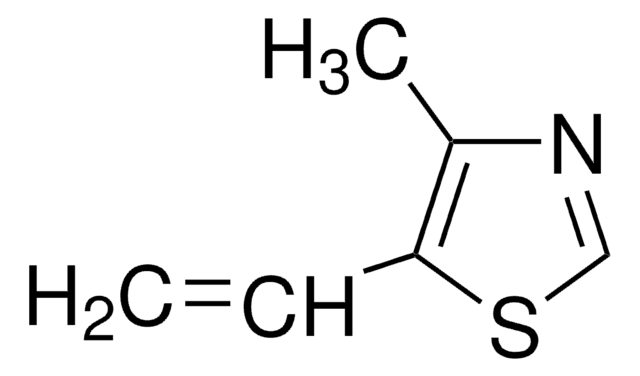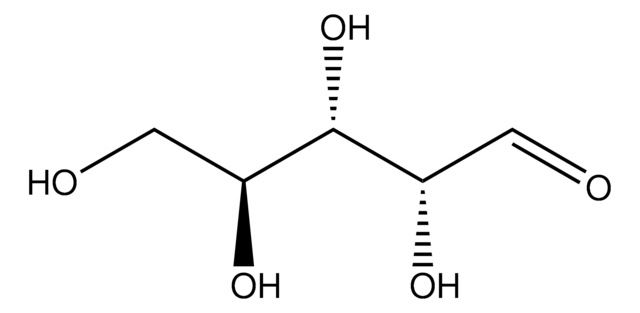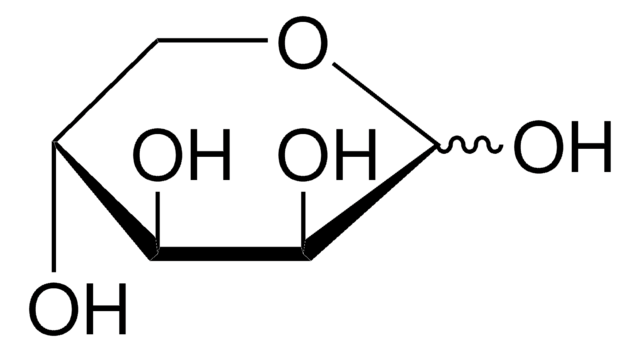W360600
D-(+)-Xylose
≥99%
Synonym(s):
(2S,3R,4S,5R)-oxane-2,3,4,5-tetrol, Dextro-xylose, Wood sugar
Sign Into View Organizational & Contract Pricing
All Photos(1)
About This Item
Empirical Formula (Hill Notation):
C5H10O5
CAS Number:
Molecular Weight:
150.13
FEMA Number:
3606
Beilstein:
1562108
EC Number:
MDL number:
UNSPSC Code:
12164502
PubChem Substance ID:
NACRES:
NA.21
Recommended Products
biological source
synthetic
Assay
≥99%
optical activity
[α]20/D +18.8°, c = 4 in H2O
mp
154-158 °C (lit.)
application(s)
flavors and fragrances
Organoleptic
smoky
SMILES string
O[C@@H]1COC(O)[C@H](O)[C@H]1O
InChI
1S/C5H10O5/c6-2-1-10-5(9)4(8)3(2)7/h2-9H,1H2/t2-,3+,4-,5?/m1/s1
InChI key
SRBFZHDQGSBBOR-IOVATXLUSA-N
Looking for similar products? Visit Product Comparison Guide
Features and Benefits
Smoky
Disclaimer
For R&D or non-EU Food use. Not for retail sale.
Storage Class Code
13 - Non Combustible Solids
WGK
WGK 1
Flash Point(F)
Not applicable
Flash Point(C)
Not applicable
Personal Protective Equipment
dust mask type N95 (US), Eyeshields, Gloves
Choose from one of the most recent versions:
Already Own This Product?
Find documentation for the products that you have recently purchased in the Document Library.
Customers Also Viewed
Shmuel Gleizer et al.
Cell, 179(6), 1255-1263 (2019-11-30)
The living world is largely divided into autotrophs that convert CO2 into biomass and heterotrophs that consume organic compounds. In spite of widespread interest in renewable energy storage and more sustainable food production, the engineering of industrially relevant heterotrophic model
Thu V Vuong et al.
PloS one, 9(4), e95170-e95170 (2014-04-17)
The xylan-binding module Clostridium thermocellum CBM22A was successfully fused to a gluco-oligosaccharide oxidase, GOOX-VN, from Sarocladium strictum via a short TP linker, allowing the fused protein to effectively bind different xylans. The presence of the CtCBM22A at the N-terminal of
Heather A Feaga et al.
mBio, 5(6), e01916-e01916 (2014-11-13)
Bacterial ribosomes frequently translate to the 3' end of an mRNA without terminating at a stop codon. Almost all bacteria use the transfer-messenger RNA (tmRNA)-based trans-translation pathway to release these "nonstop" ribosomes and maintain protein synthesis capacity. trans-translation is essential
Jose Serate et al.
Biotechnology for biofuels, 8, 180-180 (2015-11-20)
Microbial conversion of lignocellulosic feedstocks into biofuels remains an attractive means to produce sustainable energy. It is essential to produce lignocellulosic hydrolysates in a consistent manner in order to study microbial performance in different feedstock hydrolysates. Because of the potential
Wellington Muchero et al.
BMC genomics, 16, 24-24 (2015-01-24)
QTL cloning for the discovery of genes underlying polygenic traits has historically been cumbersome in long-lived perennial plants like Populus. Linkage disequilibrium-based association mapping has been proposed as a cloning tool, and recent advances in high-throughput genotyping and whole-genome resequencing
Our team of scientists has experience in all areas of research including Life Science, Material Science, Chemical Synthesis, Chromatography, Analytical and many others.
Contact Technical Service










